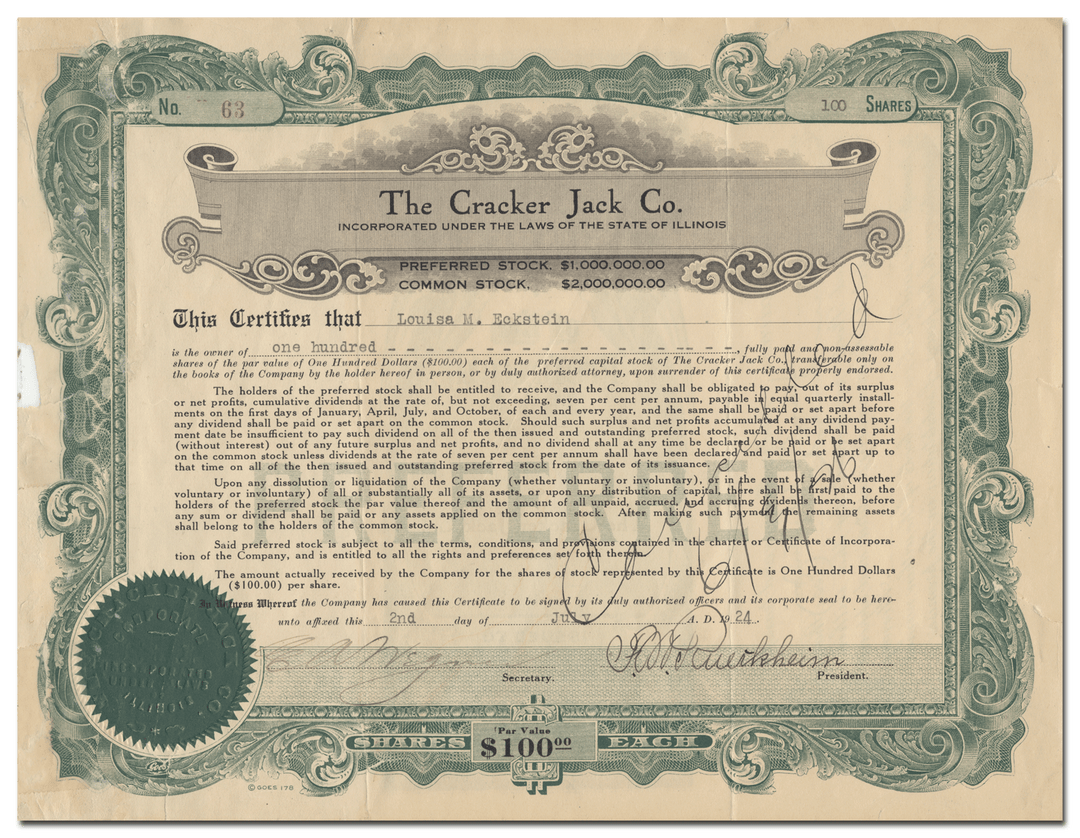
Cracker Jack Co. (signed by Frederick William Rueckheim)
- In stock
- Backordered, shipping soon
- Guaranteed authentic document
- Orders over $35 ship FREE to U. S. addresses
- Earn rewards points with every order
Product Details
CompanyCracker Jack Co.
Certificate Type
Preferred Stock
Date Issued
July 2, 1924
Canceled
Yes
Printer
Goes
Signatures
Hand signed
Approximate Size
11" (w) by 8 1/2" (h)
Images
Show the exact certificate you will receive
Guaranteed Authentic
Yes
Additional Details
Signed by Frederick William Rueckheim
Historical Context

Frederick William Rueckheim - a German immigrant known informally as "Fritz" - sold popcorn at 113 Fourth Avenue, now known as Federal Street, in Chicago beginning in 1871. The popcorn was made by hand using steam equipment. In 1873, Fritz bought out his partner, William Brinkmeyer, and brought his brother Louis Rueckheim over from Germany to join in his venture, forming the company F.W. Rueckheim & Bro. According to legend - an urban myth propagated to promote the brand by Borden Foods - stated that Rueckheim produced a popcorn confection and presented it to the public at the World's Columbian Exposition (Chicago's first world's fair) in 1893. There is no known evidence that proves that Rueckheim had an exhibit at the Columbian Exposition. In 1896, Louis discovered a method to separate the kernels of molasses-coated popcorn during the manufacturing process. As each batch was mixed in a cement-mixer-like drum, a small quantity of oil was added - a closely guarded trade secret. Before this change, the mixture had been difficult to handle, as it stuck together in chunks.
In 1896, the first lot of Cracker Jack was produced, the same year the name was registered. It was named by an enthusiastic sampler who remarked: "That's a crackerjack!" (a colloquialism meaning "of excellent quality.") The product's tagline—"The More You Eat, the More You Want, was also introduced in 1896. In 1899, Henry Gottlieb Eckstein developed the "waxed sealed package" for freshness, known then as the "Eckstein Triple Proof Package", a dust, germ, and moisture-proof paper package. In 1902, the company was reorganized as Rueckheim Bros. & Eckstein. "Take Me Out to the Ball Game", a song written by lyricist Jack Norworth and composer Albert Von Tilzer, gave Cracker Jack free publicity when it was released in 1908 with the line: "Buy me some peanuts and Cracker Jack!" In 1922, the name of the Chicago company was changed to The Cracker Jack Company.
Cracker Jack's Mascots Sailor Jack and his dog Bingo were introduced as early as 1916 and registered as a trademark in 1919. Sailor Jack was modeled after Robert Rueckheim, grandson of Frederick. Robert, the son of the third and eldest Rueckheim brother, Edward, died of pneumonia shortly after his image appeared at the age of 8. The sailor boy image acquired such meaning for the founder of Cracker Jack that he had it carved on his tombstone, which can still be seen in St. Henry's Cemetery in Chicago. Sailor Jack's dog Bingo was based on a real-life dog named Russell, a stray adopted in 1917 by Henry Eckstein, who demanded that the dog be used on the packaging. Russell died of old age in 1930.
The Cracker Jack Company was purchased by Borden in 1964 after a bidding war between Borden and Frito-Lay. Borden sold the brand to Frito-Lay parent PepsiCo in 1997, who quickly incorporated Cracker Jack into the Frito-Lay portfolio. In 2013, Frito-Lay announced that Cracker Jack would undergo a slight reformulating, adding more peanuts to Cracker Jack and updating the prizes to make them more relevant to the times.
Related Collections
Additional Information
Certificates carry no value on any of today's financial indexes and no transfer of ownership is implied. All items offered are collectible in nature only. So, you can frame them, but you can't cash them in!
All of our pieces are original - we do not sell reproductions. If you ever find out that one of our pieces is not authentic, you may return it for a full refund of the purchase price and any associated shipping charges.


